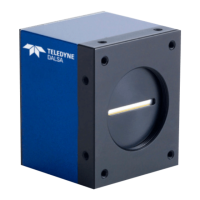Spyder3 SG-34 GigE Vision Color Manual 29
Teledyne DALSA 03-032-20124-00
Color
Also note: By default, the user settings are set to the factory settings.
Timing: Exposure and Synchronization
Image exposures are initiated by an event. The trigger event is either the camera's programmable internal
clock used in free running mode, an external input used for synchronizing exposures to external triggers,
or a programmed function call message by the controlling computer.
Trigger commands are available as members of the Line Trigger set.
GigE Vision Input Controls
The state of the line trigger. If OFF, then the line trigger is
internally generated. If ON, then triggered by an external signal.
The external source that causes a line trigger. The line trigger is
from the GPIO_PIN0. This feature is available only when Line
Trigger Mode is set to ON.
Determines the type of signal (high or low) that will cause a line
trigger. Line Trigger Mode must be ON.
External Line Trigger Frequency
Reads the external line trigger frequency. NOTE: The camera
cannot detect frequency less than 5 Hz and will display 1 if it
cannot detect a signal. This feature is available when the Line
Trigger Mode is set o ON and Sensor Direction Control is set to
External.
The three trigger modes are described here:
Free running (trigger disabled): The camera free-running mode has a programmable internal timer for
line rate and a programmable exposure period. Line rate is 0.1 fps to the maximum supported by the
sensor. Exposures range from the sensor minimum to a maximum also dependent on the curren t line rate.
This always uses Synchronous mode where exposure is aligned to the sensor horizontal line timing.
External trigger: Exposures are controlled by an external trigger signal. External signals are isolated by an
opto-coupler input with a time programmable debounce circuit. The following section provides
information on external trigger timing.
Software trigger: An exposure trigger is sent as a control command via the network connection. Software
triggers can not be considered time accurate due to network latency and sequential command jitter. But a
software trigger is more responsive than calling a single-line acquisition (Snap command) since the latter
must validate the acquisition parameters and modify on-board buffer allocation if the buffer size has
changed since the last acquisition.
All manuals and user guides at all-guides.com

